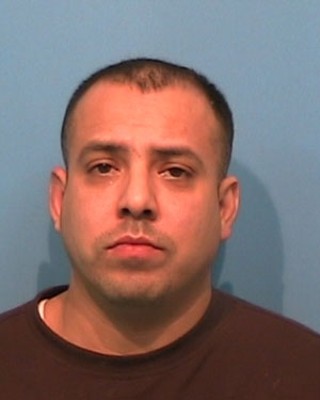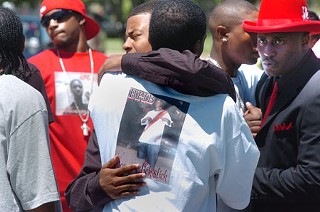The KeyPoint Report
Selected transcript of the redacted sections
Fri., May 14, 2010

Below are selections from our direct, full transcript made of the KeyPoint Government Solutions report – available on our Newsdesk blog. An anonymous source last week provided a copy of the redacted sections of the report to the Chronicle for direct review; we were not allowed to make a photocopy of the report but were given as much time as we needed to review the report and transcribe the portions that were redacted in the public version released by the city last fall. (A few editorial clarifications appear in brackets.)
The report was compiled by a group of investigators working for KeyPoint Government Solutions (the same company that conducted an independent inquiry into the 2007 officer-involved shooting death of Kevin Brown), a team including two former prosecutors and a veteran police officer. – J.S.
On Quintana's Failure to Identify Himself as a Police Officer
We agree with the findings of Internal Affairs that this allegation should be sustained against Officer Quintana. The policy requires officers to identify themselves when initiating a duty-related contact with a person unless their identity is obvious. ...
We disagree with the arguments of Sergeant Connor and Lieutenant Rodriguez that Mr. Sanders made eye contact with Officer Quintana and therefore knew he was a police officer. Looking at Officer Quintana's eyes would not alert anyone that he was an officer. Mr. Sanders would have to look at [his] uniform and there is no evidence that he did so. The point of this policy is not to assume or guess if the person knew Officer Quintana, but to have a reasonable assurance that he knew. Officer Quintana could have easily identified himself by giving verbal commands. ...
What constitutes "obvious" will depend on a number of factors such as the officer's attire, the lighting conditions, and the physical and mental conditions of the person being contacted. Officer Quintana was aware that he was going to contact two passengers in a vehicle and that both of the subjects were sleeping. The contact occurred at 5:00am, the ambient lighting was poor, the officers were wearing dark colored uniforms and the officers were shining bright flashlights into the eyes of the vehicle's occupants that would obviously impact the occupants' vision. No reasonable police officer in these circumstances would believe that their identity would be obvious. ...
We agree with the analysis of Internal Affairs that the issue of Officer Quintana's failure to identify himself has a direct bearing on whether Mr. Sanders' actions can reasonably be interpreted as those of an individual who intentionally took armed, aggressive action against someone whom he knew to be a police officer, or the instinctive defense reaction of someone, awakened from a sound sleep, in response to feeling someone grabbing his gun. A possible startled reaction is something that Officer Quintana should have anticipated and could have possibly prevented by verbally identifying himself as a police officer.
On the Failure to Follow Standardized Training and Tactics and Sound Judgment
Officer Quintana had a great deal of information available to him prior to his contact. He knew that the vehicle was associated with the white van that he had stopped and believed was involved in a series of violent armed robberies. He had received information that the suspects who had been in the white van two nights before had abandoned the van and entered a gold-colored late 1990's Mercedes station wagon. He had information that these subjects had discharged gunfire into the air when they entered the Mercedes and he knew that this had all occurred in the Walnut Creek Apartment complex. ...
Officer Quintana had the opportunity to develop additional information and at a minimum provide other officers with more information by reading off the license plate of the Mercedes to police dispatch, but he failed to do so. Through license plate information, Officer Quintana might have discovered that the vehicle was registered to Mr. Smith and he may have had the opportunity to learn of Mr. Smith's prior criminal history and gang affiliation prior to his contact.
Although it is unclear whether such additional information would have made any difference to the officers in tactics which they would utilize, it is clear that such information would have been useful. ...
The unique description of the vehicle combined with the fact that it was entering the Walnut Creek Apartments where it had been seen two days prior would create a reasonable belief for a reasonable officer that the vehicle followed by Officer Quintana was the vehicle believed to be associated with the violent felonies. The subjects wanted for the robbers that had pistol-whipped two victims, and were suspected of shooting a victim in the face during a robbery. ...
Notwithstanding these obvious risk factors, no efforts were made to have the occupants of the vehicle exit while officers were in a position of safety, or to call for additional backup and be prepared for the use of less lethal alternatives. ...
All of the officers knew of the risks imposed by making contact with subjects who were suspected of being involved in violent criminal actions yet none of them made any effort to assemble the proper police resources prior to initiating contact. ...
The officers never formulated any type of plan and there was almost no communication between the officers. ...
It is difficult to believe that an officer with Officer [John Alexander] Hitzelberg's experience would not believe that waiting behind cover, requesting additional officers and a supervisor, holding the suspects of violent crimes involving firearms at gunpoint, seeking less-lethal alternatives, developing some type of a plan and communicating the plan to all of the officers on scene might be a better option than making an unsafe approach without cover and without drawing his firearm. ...
All three officers have received training on how to perform a high-risk vehicle stop. And although the officers did not actually stop the car in the traditional sense, they were still dealing with a high-risk situation where the suspects were inside [the] car and any reasonable police officer would have applied the same training. The basic concept taught to officers for conducting a high-risk car stop is to remain behind cover, keeping the suspects at gunpoint, order the suspects to come out of the car and back toward the officers in a very specific manner where the officers can take the suspects into custody. A main component was that all officers involved in the stop would have clearly communicated roles and areas of responsibility to prevent confusion in the event action was required.
All of the officers stated that they were familiar with the "Felony/High-Risk" concepts and had either used them or seen them in use while an Austin Police officer. In the High-Risk training, students are taught the importance of planning, timing and coordination, and the division of critical tasks among officers. None of these factors were discussed by the officers prior to the beginning of their approach. There was no discussion between the officers of tactics, roles, and responsibilities, or contingencies should the need to take action arise, nor did the officers discuss any alternatives for handling the situation. ...
Conclusion Regarding Tactics and Training
These officers were confronting individuals whom they believed to be armed and who had committed a series of violent crimes. It makes little difference if the suspects were standing in the street, sitting on a park bench or in a vehicle. Police officers are trained to use reasonable officer safety tactics when they are approaching someone who may be armed. Walking up to the suspects without any planning, without requesting assistance, without drawing their guns, without identifying themselves, without giving the suspects any orders, without seeking any cover, without any less-lethal options is simply not reasonable and certainly the standardized training of the Austin Police Department would teach officers not to act in this manner.
Unsound decisions in the [face] of predictable violent behavior sometimes set a series of events into motion that can result in tragedy. The degree of tragedy is magnified when the police have the opportunity to plan, to summon resources, and to [respond] in tactically sound manner, but fail to do so through incompetence, laziness, bravado or expediency. It was just this type of tactical failure by Officers Quintana, Hitzelberg and [Mohammad] Siddiqui that forced the officers to extricate themselves from a dangerous position that they created which results in the death of Mr. Sanders and the injuries to Mr. Smith.
We believe the actions taken by Officer Quintana were well beyond merely careless or negligent. We believe his actions, based on his knowledge of the circumstances, his training – particularly with his attendance in the SWAT course and Patrol Tactical course, his experience as a veteran police officer and his status as a field training officer – were reckless to the point that he needlessly endangered himself, his fellow officers, the suspects and the onlookers.
We characterize Officer Quintana's tactics as reckless mindful of the legal import of the term. Reckless conduct can be criminal if it involves taking actions knowing that they are likely to yield a particular result but the actor does so despite the risk. ...
[I]t is not within the scope of our review to render opinions regarding possible criminal conduct. We place our findings against the backdrop of the Texas Penal Code to emphasize the gravity of this sustained allegation against Officer Quintana. It is not a long stretch between finding that Officer Quintana disregarded standardized Departmental training and tactics in confronting potentially armed suspects resulting in his killing one and wounding the other, and finding that he disregarded the substantial and unjustifiable risk that he would lose control of the volatile situation resulting in having to use deadly force. ...
[W]e also believe that the instant allegation should be sustained against Officer Hitzelberg. ... Officer Hitzelberg could have chosen to speak out when he recognized the tactics were unreasonable and reckless based on the circumstances, but he failed to intervene and acted just as recklessly as Officer Quintana by failing to plan and failing to even unholster his weapon.
Officer Siddiqui also knew why they were contacting the Mercedes. ... He should ... be held accountable for failing to exercise even the most basic officer safety strategy of unholstering his firearm and using cover when attempting to contact individuals whom any reasonable police officer would believe to be armed.
On the Use of Deadly Force Against Nathaniel Sanders II
As noted above we believe that Officer Quintana's tactics were reckless and that if Officer Quintana employed even the most basic officer safety tactics in this situation as he had been trained, the necessity to use deadly force may very well have been avoided. ...
We believe that the totality of the circumstances must be reviewed in assessing Officer Quintana's use of deadly force, not just the "final frame" or the instant before the force was used. Indeed we are mandated to do so by the policies of the Austin Police Department. ...
In this case the totality of the circumstances include the fact that Officer Quintana had sufficient information prior to making contact with the occupants of the Mercedes that would cause a reasonable officer to have a reasonable belief that the occupants of the Mercedes were armed and dangerous and that reasonable police tactics should be implemented to protect the community, the officers and the suspects. Not only did the officers fail to implement reasonable police tactics to address the contact, instead they acted recklessly and their actions provoked an officer-involved shooting that otherwise may not have been necessary. ...
Officer Quintana actually had a significant amount of time to know, understand and process the information prior to his decision to use deadly force. This is not a situation where an officer was suddenly confronted with a life and death decision, but rather an event that evolved over time. As we have already discussed, time and distance are allies of police tactics and Officer Quintana's reckless judgment in rushing and eliminat[ing] the safety of distance are the primary factors that caused these tragic consequences. We do not believe that Officer Quintana was forced to make critical split-second decisions and therefore we do not believe that decision-making time frame, even if Officer Quintana's actions at that point were arguably reasonable (which we don't believe), should serve as mitigation for his acts. Instead, we believe that he had sufficient time to recognize and understand the issues presented and that a reasonable officer would have employed reasonable tactics to address [the] risk presented by this situation. ...
Indeed, even under consideration of only the last frame of the analysis, we find that Officer Quintana's decision to use deadly force was a violation of department policy in that a reasonable police officer in such situation would not have employed deadly force by shooting at a silhouette knowing only that the individual was armed with a gun, especially under circumstances where cover was readily available. ...
On the Use of Deadly Force Against Sir Smith
It is again important to note that the allegation as drawn requires a review of the totality of the circumstances. As we have discussed, Officer Quintana's disregard of proper tactics was the catalyst through which a dangerous police encounter became a shooting incident. Based on Officer Quintana's reckless tactics alone, we believe that this allegation should be sustained. ...
Further, we do not believe that the physical evidence comports with Officer Quintana's version of the events. ...
We find that Officer Quintana saw the front passenger door open suddenly and Mr. Smith was trying to run from the vehicle to get away from the gunshots. When one considers that it takes some time to perceive, react, decide and fire his handgun and because of the timing of the shots and the time that it took for Mr. Smith to be visible in the video at the back of the Cavalier, it is reasonable to believe that Mr. Smith was shot just after he exited the Mercedes and the decision to shoot was in reaction to the car door opening suddenly. Based on this reasoning, Officer Quintana could not have made his decision to use deadly force due to Mr. Smith's hand placement, but more logically Officer Quintana made his decision to use deadly force when Mr. Smith suddenly opened the car door. ...
Ultimately it is our finding that significant tactical errors that rose to the level of recklessness were made by the involved officers, and that but for this recklessness the use of deadly physical force might very well have been avoided. While we have also found that the use of deadly physical force by Officer Quintana was not justified, as any belief that there was an imminent danger to himself or others was not objectively reasonable, it was ultimately the reckless tactics employed by Officer Quintana in the first place that directly led to his use of deadly force and ultimately the taking of the life of one individual and seriously wounding of another.
Got something to say on the subject? Send a letter to the editor.









